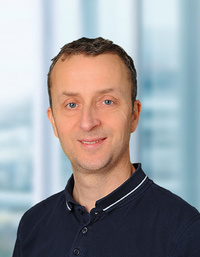CHANNELS

Group Leader
Dr. Martin Höhne
+49 221 478-84174
martin.hoehne@uk-koeln.de
TEAM MEMBERS
Marie Brand, MD
Stefanie Keller
Martin Höhne
Systems Biology of Aging
Aging society
Without any doubt, we live in an ageing society. In fact, aging is considered as one of the global issues for the United Nations (1). Dealing with the socio-economic consequences of this demographic change is a challenging task for our society (2).
As biomedical researchers we are convinced that an important contribution will be to find and develop treatments/interventions that are beneficial against aging-related diseases and aging-related health decline. The ultimate goal is not to prolong life-span, but to prolong the individual “health span”.
References and links:
Systems Biology of Ageing
This goal can only be achieved if we gain a deeper understanding of the ageing process on a cellular, molecular and organismal level (3). We therefore joined forces with other researchers from Cologne (from University, CECAD, and the Max Planck Institute for Biology of Ageing) to work on these questions with a systems biology approach. This research area is developed within the “Systems Biology of Ageing Cologne – Sybacol” consortium funded by the German Federal Ministry of Education and Reseach (BMBF). More information can be found on the consortiums web page at www.sybacol.org (4).
SELECTED PUBLICATIONS
Unnersjo-Jess, D., Butt, L., Hohne, M., Witasp, A., Kuhne, L., Hoyer, P.F., Patrakka, J., Brinkkotter, P.T., Wernerson, A., Schermer, B., Benzing, T., Scott, L., Brismar, H., and Blom, H. (2021) A fast and simple clearing and swelling protocol for 3D in-situ imaging of the kidney across scales. Kidney Int, 99(4): 1010-1020.
Butt, L., Unnersjo-Jess, D., Hohne, M., Edwards, A., Binz-Lotter, J., Reilly, D., Hahnfeldt, R., Ziegler, V., Fremter, K., Rinschen, M.M., Helmstadter, M., Ebert, L.K., Castrop, H., Hackl, M.J., Walz, G., Brinkkoetter, P.T., Liebau, M.C., Tory, K., Hoyer, P.F., Beck, B.B., Brismar, H., Blom, H., Schermer, B., and Benzing, T. (2020) A molecular mechanism explaining albuminuria in kidney disease. Nat Metab, 2(5): 461-474.
Hohne, M., Frese, C.K., Grahammer, F., Dafinger, C., Ciarimboli, G., Butt, L., Binz, J., Hackl, M.J., Rahmatollahi, M., Kann, M., Schneider, S., Altintas, M.M., Schermer, B., Reinheckel, T., Gobel, H., Reiser, J., Huber, T.B., Kramann, R., Seeger-Nukpezah, T., Liebau, M.C., Beck, B.B., Benzing, T., Beyer, A., and Rinschen, M.M. (2018) Single-nephron proteomes connect morphology and function in proteinuric kidney disease. Kidney Int, 93(6): 1308-1319.
Schurek, E.M., Volker, L.A., Tax, J., Lamkemeyer, T., Rinschen, M.M., Ungrue, D., Kratz, J.E., 3rd, Sirianant, L., Kunzelmann, K., Chalfie, M., Schermer, B., Benzing, T., and Hohne, M. (2014) A disease-causing mutation illuminates the protein membrane topology of the kidney-expressed prohibitin homology (PHB) domain protein podocin. J Biol Chem, 289(16): 11262-71.
Volker, L.A., Schurek, E.M., Rinschen, M.M., Tax, J., Schutte, B.A., Lamkemeyer, T., Ungrue, D., Schermer, B., Benzing, T., and Hohne, M. (2013) Characterization of a short isoform of the kidney protein podocin in human kidney. BMC Nephrol, 14: 102.
Hohne, M., Ising, C., Hagmann, H., Volker, L.A., Brahler, S., Schermer, B., Brinkkoetter, P.T., and Benzing, T. (2013) Light microscopic visualization of podocyte ultrastructure demonstrates oscillating glomerular contractions. Am J Pathol, 182(2): 332-8.
Volker, L.A., Petry, M., Abdelsabour-Khalaf, M., Schweizer, H., Yusuf, F., Busch, T., Schermer, B., Benzing, T., Brand-Saberi, B., Kretz, O., Hohne, M., and Kispert, A. (2012) Comparative analysis of Neph gene expression in mouse and chicken development. Histochem Cell Biol, 137(3): 355-66.
Hohne, M., Lorscheider, J., von Bardeleben, A., Dufner, M., Scharf, M.A., Godel, M., Helmstadter, M., Schurek, E.M., Zank, S., Gerke, P., Kurschat, C., Sivritas, S.H., Neumann-Haefelin, E., Huber, T.B., Reinhardt, H.C., Schauss, A.C., Schermer, B., Fischbach, K.F., and Benzing, T. (2011) The BAR domain protein PICK1 regulates cell recognition and morphogenesis by interacting with Neph proteins. Mol Cell Biol, 31(16): 3241-51.
